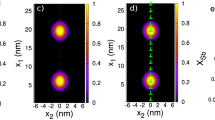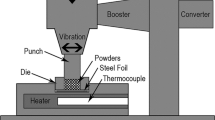Abstract
The structural properties of overpressurised helium precipitates formed by low dose ion implantation and subsequent annealing of silicon are investigated by quantitative transmission electron microscopy techniques. These precipitates, which show pronounced platelet geometry, are analysed with respect to their geometry, crystallographic orientation and their particular gas pressure values. The dependence of the measured platelet pressure versus the radius is discussed in terms of a Griffith crack. Experimental results on the shape and the crystallographic orientation of the platelets are discussed in the framework of anisotropic elastic properties and surface energies of silicon. The ability of the precipitates to punch-out dislocation loops is discussed in terms of associated threshold shear stress values and evaluated with regard to the defect size dependency.








Similar content being viewed by others
References
Trinkaus H (1983) Rad Effects 78:189
Donnelly SE (1985) Rad Effects 90:1
van Veen A (1991) In: Donnelly SE and Evans JH (eds) Fundamental aspects of inert gases in solids, Plenum Press, New York, p 41
Holländer B, St. Lenk, Mantl S, Trinkaus H, Kirch D, Luysberg M, Herzog H-J, Hackbarth T, Fichtner PFP (2001) Nucl Instr Meth Phys Res B 175–177:357
Fichtner PFP, Kaschny JR, Yankov RA, Mücklich A, Kreißig U, Skorupa W (1996) Appl Phys Lett 61:2656
Trinkaus H, Holländer B, St. Rongen, Mantl S, Herzog HJ, Kuchenbecker J, Hackbarth T. (2000) Appl Phys Lett 76:3552
Herve AJ, Bruel M (2000) Int J High Speed Electronics Syst 10:131
Luysberg M, Kirch D, Trinkaus H, Holländer B, St. Lenk, Mantl S, H.-Herzog J, Hackbarth T, Fichtner PFP (2002) J Appl Phys 92:4290
Hartmann M, Trinkaus H (2002) Phys Rev Lett 88:055505
Biersack JP, Haggmark L (1980) Nucl Instr Meth 174:257
Cerofolini GF, Corni F, Frabboni S, Nobili C, Ottaviani G, Tonini R (2000) Mater Sci Eng Reports 27:1
Fichtner PFP, Kaschny JR, Behar M, Yankov RA, Mücklich A, Skorupa W (1999) Nucl Inst Meth 148:329
Oliviero E, Beafort MF, Barbot JF (2001) J Appl Phys 89:5332
Ashby MF, Brown LM (1963) Phil Mag 8:1649
Ashby MF, Brown LM (1963) Phil Mag 8:1083
Raineri V, Saggio M (1997) Appl Phys Lett 71:1673
Brusa RS, Karwasz GP, Tiengo N, Zecca A (2000) Phys Rev B61:10154
Chen J, Jung P, Trinkaus H (2000) Phys Rev B61:12923
Fichtner PFP, Kaschny JR, Kling A, Trinkaus H, Yankov RA, Mücklich A, Skorupa W, Zawislak FC, Amaral L, da Silva MF, Soares JC (1998) Nucl Inst and Meth B 136–138:460
Hellwege K-H (eds) (1982) Landolt-Börnstein: numerical data and functional relationships in science and technology. New Series, Springer-Verlag, Berlin, p 17
Tillmann K, Hueging N, Trinkaus H, Luysberg M, Urban K (2004) Microsc Microanal 10:199
Howie A, Whelan MJ (1961) Proc R Soc A163:217
Howie A, Whelan MJ (1962) Proc R Soc A267:217
Griffith A (1921) Trans R Soc A221:163
Hirth JP, Lothe J (1968) Theory of dislocations. McGraw-Hill, New York
Hueging N, Luysberg M, Urban K, Buca D, Mantl S (2005) Appl Phys Lett 86:042112
Eaglesham DJ, White AE, Feldman LC, Moriya N, Jacobson DC (1993) Rev Lett 70:1643
Acknowledgements
The authors cordially thank Bernd Holländer and Siegfried Mantl for the fruitful cooperation during realisation of the implantation experiments, for guidance of the SRIM calculations as well as for helpful discussions.
Author information
Authors and Affiliations
Corresponding author
Rights and permissions
About this article
Cite this article
Hueging, N., Luysberg, M., Trinkaus, H. et al. Quantitative pressure and strain field analysis of helium precipitates in silicon. J Mater Sci 41, 4454–4465 (2006). https://doi.org/10.1007/s10853-006-0153-1
Received:
Accepted:
Published:
Issue Date:
DOI: https://doi.org/10.1007/s10853-006-0153-1




